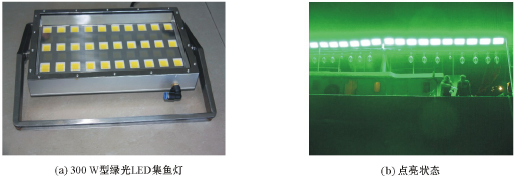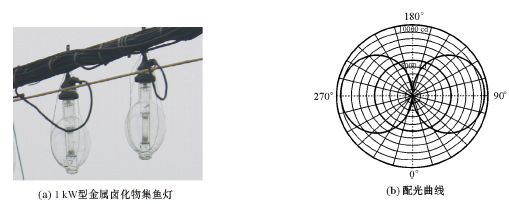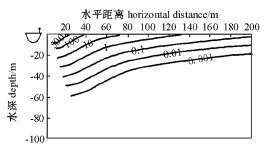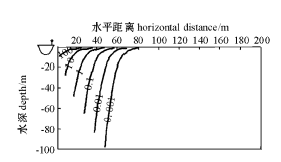(1. College of Marine Sciences, Shanghai Ocean University, Shanghai 201306, China; 2. National Engineering Research Center for Distant-Water Fisheries, Shanghai 201306, China; 3. Key Laboratory of Sustainable Exploitation of Oceanic Fisheries Resources, Ministry of Education, Shanghai 201306, China)
The green light LED fish-attracting lamp was developed through collaboration between the Squid Fishing Technology Group of Shanghai Ocean University and Shanghai Jiabao Electronics Co., Ltd. After extensive preliminary investigations and scheme design, building on the research and development of the first-generation LED fish-attracting lamp (300 W white light) [12], the second-generation LED fish-attracting lamp (300 W green light) was developed (Figure 1). Based on a comprehensive consideration of the design of this green light LED fish-attracting lamp, it is preliminarily believed that it not only possesses all the excellent properties of the 300 W white light LED fish-attracting lamp [12], but also the emitted green light has a higher transmittance in seawater, effectively avoiding unnecessary waste of light energy. In addition, its spectral range (490–560 nm) is very close to the spectral absorption peak range of cephalopods (wavelength 460–530 nm) [13-16], making it more suitable for attracting cephalopods.

Green light LED lamp(300 W)for fish aggregation and luminescence

The metal halide lamp(1 kW)for fish aggregation and its distribution of luminous intensity
The basic parameters of domestic metal halide lamp(1 kW)for fish aggregation

Illuminance of two types of fish aggregating lamps at different distances

The spectral irradiance of the green LED fish - attracting lamp and the 1 kW metal halide fish - attracting lamp is shown in Figure 5. It can be seen from Figure 5 that the spectral radiation of the green LED fish - attracting lamp is mainly concentrated in the green light band (490 - 560 nm); while the 1 kW metal halide fish - attracting lamp has a very wide spectral range, which not only includes the entire visible light (with a wavelength of 380 - 760 nm), but also some ultraviolet and infrared rays. At the same time, there are peaks in some bands (such as around wavelengths of 360, 400, 430, 480, 510, 540, 590 nm, etc.). Compared with the 1 kW metal halide fish - attracting lamp, the green LED fish - attracting lamp emits light only in the green spectral part, does not produce ultraviolet rays, and will not have a negative impact on the eyes and skin of crew members.

Distribution of underwater is illuminance curves when the total power of 1 kW metal halide fish-collecting lamps is 62 kW

When the total power of the green light LED fish-attracting lamp is 9 kW, the illuminance value within a horizontal distance of 40 m from the ship is relatively high, mostly above 10 lx. Especially, the illuminance in the near-surface water within 20 m from the ship can reach more than 100 lx. The 10 lx illuminance can reach the deepest depth of 30 m, with the farthest horizontal distance from the ship being about 36 m; the 0.1 lx illuminance can reach the deepest depth of approximately 65 m, with the farthest horizontal distance from the ship being about 50 m.
Distribution of underwater is illuminance curves when the total power of LED fish-attracting lamps is 9 kW

LED lights are known as the world's latest fourth-generation light source, with advantages such as long lifespan, low energy consumption, directionality, and no light source pollution [17]. They were gradually promoted in the marine fishing industry in the late 1990s. Relevant authorities in Japan and Taiwan, China have successfully promoted and applied LED fish-attracting lights in saury purse seine and light purse seine fisheries [18-21]. However, due to the disadvantage of slow heat dissipation in LED light-emitting modules, it is not easy to design single-lamp fixtures with too high power. Therefore, the single-lamp power of LED fish-attracting lights developed in Japan and Taiwan, China is relatively small, generally ranging from 60 to 220 W. Our research team adopted water cooling technology (this technology has applied for a patent), which effectively solved the problem of heat generation in LED fish-attracting light fixtures. This allows the power of a single LED fish-attracting light fixture to exceed 300 W, providing better conditions for the reasonable arrangement and installation of LED fish-attracting lights on fishing boats.
Compared with the currently commonly used white light metal halide fish-attracting lights, green LED fish-attracting lights have less energy loss when propagating in seawater, thus having better penetration, and the light can effectively reach deeper water layers. At the same time, the spectral radiation of green LED fish-attracting lights is mainly concentrated in the green light band (490-560 nm), which is close to the blue-green light band preferred by squid and other species [13, 16], which is beneficial to attracting the target catch close to the fishing boat. However, the fish-attracting effect of green LED fish-attracting lights in actual fisheries still needs further research.
Relevant studies believe that the comprehensive light source efficiency of cyan LED is more than 32 times that of metal halide lamps, and it can save more than 50% of the total fuel consumption while ensuring that the squid fishing catch remains unchanged [18]. The results of this study show that green LED fish-attracting lights have many excellent properties, such as long lifespan, low power consumption, low heat generation, instant lighting and extinguishing, high transmittance in seawater, use of low-voltage power supply, no need to install ballasts, no ultraviolet rays generated, etc. They can meet the needs of light-induced fisheries and have great potential for energy conservation.
It is an indisputable fact that LEDs have broad application prospects, but the research and development of LED fish-attracting lights for fisheries is still in the primary stage. Although some batches of domestic LED fish-attracting lights are already available and fishery production tests have been carried out, there are still many research works that need to be further followed up, such as: determining the power of a single lamp, selecting the main spectrum, reasonably arranging LED fish-attracting lights on the boat, determining the total power for different fishing methods and different target catches, and also conducting spectrum measurement and irradiance determination, etc. The in-depth development of these research works requires the support of relevant functional departments and enterprises.
Contact: Tim Jiang
Phone: 18616622550
Tel: 021-36525032
Email: tim@fishlamps.com
Add: No.2710 Fengxiang Road, Jiading Dist, shanghai, China